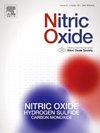CYR119, a central nervous system-penetrant stimulator of soluble guanylyl cyclase, improves survival in a mouse model of resuscitation after cardiac arrest
IF 3.2
2区 生物学
Q2 BIOCHEMISTRY & MOLECULAR BIOLOGY
引用次数: 0
Abstract
Background
Treatment with inhaled nitric oxide (NO) improves rates of survival and neurologic outcomes in a mouse model of resuscitation after cardiac arrest. The effect of NO is dependent on the soluble guanylyl cyclase/cyclic guanosine monophosphate (NO-sGC-cGMP) pathway. NO-sGC is a potential target for drugs to modulate NO-dependent signaling in conditions that include ischemia-associated inflammation. The objective of this study was to determine whether CYR119, a stimulator of NO-sGC that can penetrate the central nervous system, improves outcomes after resuscitation from cardiac arrest.
Methods
Adult C57BL/6J wild-type mice of both sexes were subjected to potassium chloride-induced cardiac arrest and cardiopulmonary resuscitation. Fifteen minutes after the return of spontaneous circulation, mice were randomized to receive subcutaneous injections of either CYR119 or vehicle alone. The length of survival after the procedure and degree of neurological dysfunction were assessed. A composite outcome measure was used to define a good outcome as survival with good neurological function, while a poor outcome was defined as either death or exhibiting poor neurologic function. In addition, mRNA levels of inflammatory cytokines in the brain and a plasma marker of kidney injury were measured.
Results
CYR119 significantly improved 10-day survival (35 % in CYR119-treated mice; 15 % in vehicle-treated mice) and the likelihood of achieving a good outcome, demonstrating an association between treatment and both survival and neurological recovery. CYR119-treated mice also exhibited reduced transcript levels of TNF⍺ and IL-1β in the hippocampus and cortex, respectively, and lower plasma creatinine levels.
Conclusion
The current study revealed that CYR119 substantially improved the likelihood of survival with good neurologic function in mice resuscitated from cardiac arrest. The beneficial effects of post-arrest treatment with CYR119 were associated with decreased mRNA expression of inflammatory cytokines in the brain and decreased plasma creatinine levels, suggestive of renal protection. These findings support the potential of CYR119 as a therapeutic strategy for post-cardiac arrest recovery.
CYR119是一种中枢神经系统渗透性刺激剂,可提高心脏骤停后复苏小鼠模型的存活率。
背景:在心脏骤停后复苏的小鼠模型中,吸入一氧化氮(NO)治疗可提高生存率和神经系统预后。NO的作用依赖于可溶性鸟苷环化酶/环鸟苷单磷酸(NO- sgc - cgmp)途径。NO-sGC是药物在包括缺血相关炎症在内的条件下调节no依赖信号的潜在靶点。本研究的目的是确定CYR119是否可以改善心脏骤停复苏后的预后,CYR119是一种可以穿透中枢神经系统的NO-sGC刺激剂。方法:采用氯化钾诱导的C57BL/6J野生型成年小鼠进行心脏骤停和心肺复苏。自发循环恢复15分钟后,小鼠被随机分为皮下注射CYR119或单独注射CYR119。评估术后生存时间和神经功能障碍程度。使用复合结果测量将良好结果定义为具有良好神经功能的生存,而不良结果定义为死亡或表现出不良神经功能。此外,还测量了脑内炎症细胞因子mRNA水平和血浆肾损伤标志物。结果:CYR119显著提高了10天生存率(CYR119治疗小鼠为35%,载体治疗小鼠为15%)和获得良好结果的可能性,表明治疗与生存和神经恢复之间存在关联。cyr119处理的小鼠也分别表现出海马和皮质中TNF和IL-1β转录水平降低,血浆肌酐水平降低。结论:目前的研究表明,CYR119显著提高了心脏骤停复苏小鼠存活并具有良好神经功能的可能性。CYR119停搏后治疗的有益效果与脑中炎症细胞因子mRNA表达降低和血浆肌酐水平降低相关,提示肾保护作用。这些发现支持CYR119作为心脏骤停后恢复治疗策略的潜力。
本文章由计算机程序翻译,如有差异,请以英文原文为准。
求助全文
约1分钟内获得全文
求助全文
来源期刊

Nitric oxide : biology and chemistry
生物-生化与分子生物学
CiteScore
7.50
自引率
7.70%
发文量
74
审稿时长
52 days
期刊介绍:
Nitric Oxide includes original research, methodology papers and reviews relating to nitric oxide and other gasotransmitters such as hydrogen sulfide and carbon monoxide. Special emphasis is placed on the biological chemistry, physiology, pharmacology, enzymology and pathological significance of these molecules in human health and disease. The journal also accepts manuscripts relating to plant and microbial studies involving these molecules.
 求助内容:
求助内容: 应助结果提醒方式:
应助结果提醒方式:


